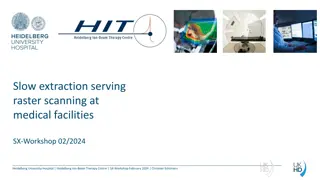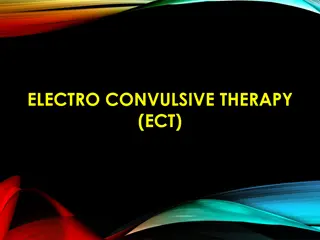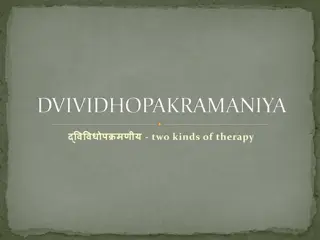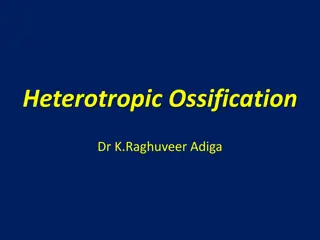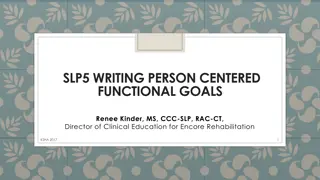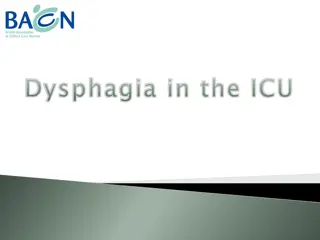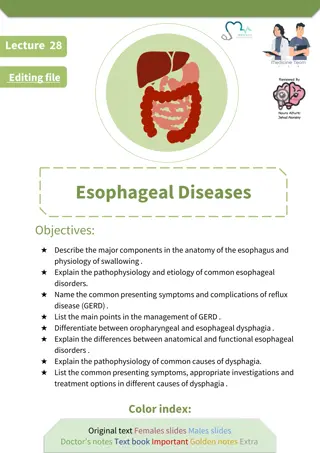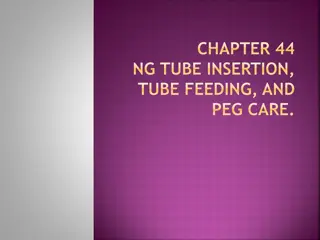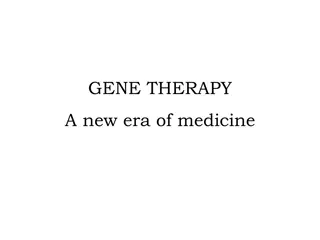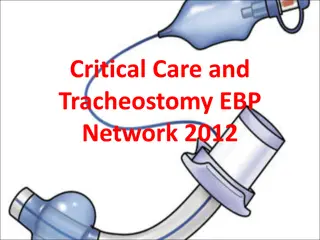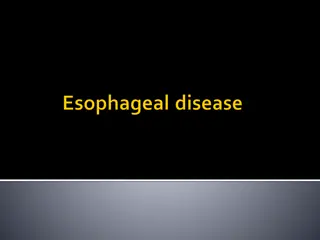Dysphagia Therapy in Myositis Population
Dysphagia therapy in the myositis population is explored through various research studies, including interventions, outcomes, and effectiveness of different approaches. The Mendelsohn maneuver shows promise in maintaining oral intake, highlighting the complexity of dysphagia management in this context.
Download Presentation

Please find below an Image/Link to download the presentation.
The content on the website is provided AS IS for your information and personal use only. It may not be sold, licensed, or shared on other websites without obtaining consent from the author.If you encounter any issues during the download, it is possible that the publisher has removed the file from their server.
You are allowed to download the files provided on this website for personal or commercial use, subject to the condition that they are used lawfully. All files are the property of their respective owners.
The content on the website is provided AS IS for your information and personal use only. It may not be sold, licensed, or shared on other websites without obtaining consent from the author.
E N D
Presentation Transcript
NSW Speech Pathology EBP Network Hunter EBP Group 9 members Leader: Wendy Hackney
Clinical Question Is dysphagia therapy indicated (and if so, what therapy is most effective) for people in the myositis population?
What did we find? Authors Number of participants Research Design Johnson, L.G; Collier, K.E; et al (2009). Improvement in Aerobic Capacity After an Exercise Program in Sporadic Inclusion Body Myositis. Journal of Clinical Neuromuscular Disease. 10 (4) 7 Experimental design Jones, K., Pitceathly, R., Rose, M., McGowan, S., Hill, M., Badrising, U., and Hughes, T. (2016) Interventions for dysphagia in long-term progressive muscle disease (review). The Cochrane Library, Issue 1 22 Review of randomised and quasi-randomised controlled trials Ko, E.H; Rubin, M.D (2014). Dysphagia due to inclusion body myositis: Case Presentation and Review of the Literature. Annals of Otology, Rhinology & Laryngology. 123 (9), 605-608 1 Single-case study
What did we find? Authors Number of participant s Research Design Kyoung Min Kwon, MD, Jung Soo Lee, MD, Yeo Hyung Kim, MD. (2018). A case report of life- threatening acute dysphagia in dermatomyositis. Challenges in diagnosis and treatment. Medicine (Baltimore). 97(17); e508. 1 Single case study Munters, et al (2013) Improvement in Health and Possible Reduction in Disease Activity Using Endurance Exercise in Patients with established Polymyositis and Dermatomyositis: A Multicentre randomized controlled trial with 1-year open extension followu p. Arthritis Care & Research Vol. 65, No.12, December 2013, pp 1959-1968. DOI 10.1002/acr.22068, 2013, American College of Rheumatology. 23 RCT not looking directly at speech pathology related parameters though
What did we find? Authors Number of participants Research Design Oh, T.H; Brumfield, K.A; Hoskin, T.L; Stolp, K.A (2007) Dysphagia in Inflammatory Myopathy: Clinical Characteristics, Treatment Strategies, and Outcome in 62 Patients. Mayo Clinic Proceedings, 82 (4), pp441-447 783 files reviewed Retrospective medical case note review only (5 year calendar period). No intervention or control group. Does not meet a study design criteria (closest to a ?cross- sectional study) Oh, T. H., Brumfield, K. A., Hoskin, T. L., Kasperbauer, J. L., & Basford, J. R. (2008). Dysphagia in inclusion body myositis: clinical features, management, and clinical outcome. American journal of physical medicine & rehabilitation, 87(11), 883-889 26 Cohort study, retrospective analysis
Summary of papers found 7 relevant papers identified In total, 80 participants across evidence + case reviews of 783 files Overall level of the evidence base IV (x4), III-2 (x1), II (x2) The Mendelsohn manoeuver seemed helpful in maintaining oral intake in the three patients in whom it was recommended, as these patients maintained oral intake (1-5 years) without aspiration related illness or weight loss. However, none of these patients had repeat VFSS. Study suggests that dysphagia in this population may have pharyngeal as well as oesophageal involvement. Pharyngeal dysphagia appears to be due to impaired pharyngeal muscle contraction stemming from weakness in the suprahyoid muscle than the more commonly held belief of failed UES relaxation.
Summary of papers found The oesophagus is the most common organ involved in IBM and dysphagia is often the main presenting symptom. The mechanism of dysphagia in IBM resembles that in other inflammatory myopathies and is related to inadequate pharyngeal contraction, poor relaxation of the cricopharyngeus muscle, and reduced hyolaryngeal elevation. Unlike other inflammatory myopathies, dysphagia in IBM is steroid resistant. Prognosis is worse in pts with IBM than those with DM or PM, likely because of increased risk of aspiration pneumonia and poor response to therapy.
Summary of papers found The Mendelsohn manoeuvre and diet modification may be useful to help pts maintain stable weight and reduce aspiration risk. IVIg and balloon dilation therapy are considered treatment options although dysphagia typically recurs and efficacy gradually diminishes over time. Surgical intervention (cricopharyngeal myotomy) has been suggested when conservative management fails or when severe weight loss/malnutrition are evident but should be very carefully considered by ENT. Myotomy is most effective when there is hypertonicity of the cricopharyngeus and impaired relaxation. Further research studies are needed examining therapy/treatments and measuring outcomes (including instrumental results and QOL outcomes) for people with IBM.
Clinical bottom line There is no established best practice for managing dysphagia in chronic muscle disease. There is insufficient and low-quality RCT evidence to determine the effect of intervention for dysphagia in long-term, progressive muscle disease. No studies investigated indirect dysphagia exercises in adults with long-term progressive muscle disease. The Mendelsohn manoeuver seemed helpful in maintaining oral intake in the three patients in whom it was recommended, as these patients maintained oral intake (1-5 years) without aspiration related illness or weight loss. However, none of these patients had repeat VFSS. Further research is required to determine the effect of implementing the Mendelsohn manoeuvre for patients with inclusion body myositis related dysphagia. Utility of rehabilitation measures unclear. Determining rehabilitation treatment effect is complicated by the inability to separate fluctuations in the disease course, or responses to medical or surgical treatment Study suggests that dysphagia in this population may have pharyngeal as well as oesophageal involvement. Pharyngeal dysphagia appears to be due to impaired pharyngeal muscle contraction stemming from weakness in the suprahyoid muscle than the more commonly held belief of failed UES relaxation.
What is our clinical group currently working on/plans for the future? Due to reduction in member numbers we have decided to take a break in 2020. This is largely due to the increase in our clinical loads and staff movement between sites.


